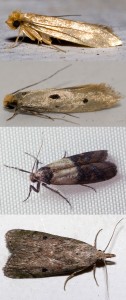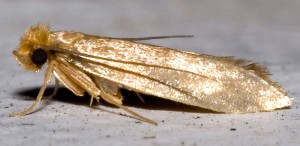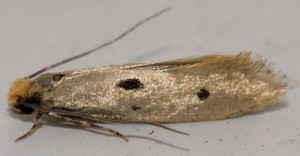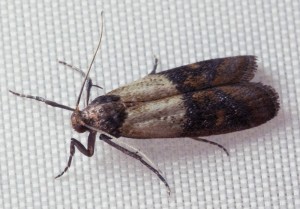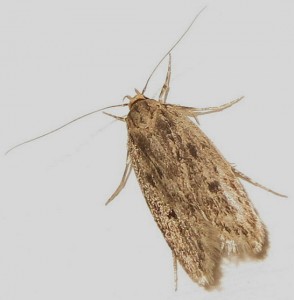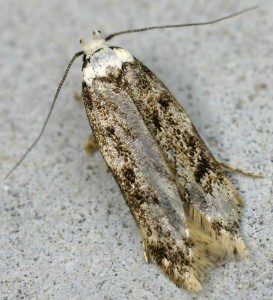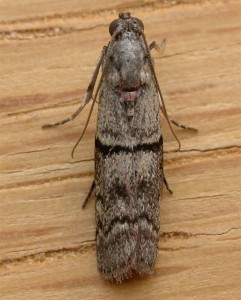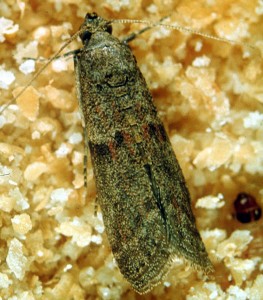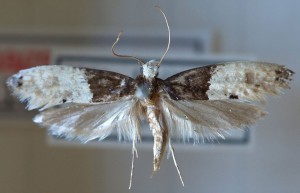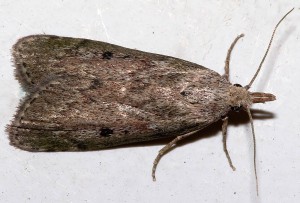Facts About Moth Species
It is estimated that there are around 160,000 species of moths in the world, with approximately 12,000 species in the US, excluding certain small butterflies. However, only about 50 – 100 of these species are considered actual pests, with only 5 being commonly found.
In this article, you can learn about most of the moth species considered pests in the US. In some sections, there are links to more detailed articles on specific moth species.
Common Moth Species
Among the moth species considered pests, the following are the most common in US households:
Clothes Moth
The clothes moth(Tineola bisselliella) is very similar to the case-bearing clothes moth. The most notable difference is that the case-bearing clothes moth has three black spots on each wing, which the clothes moth lacks. However, these spots can wear off.
The larvae of the clothes moth feed on organic materials such as wool, fur, silk, feathers, hair, and similar items. Therefore, they are often found in textiles such as stored clothing, carpets, upholstery, and the like.
Case-bearing Clothes Moth
The case-bearing clothes moth (Tinea pellionella) closely resembles the clothes moth, as mentioned above, with the main distinguishing feature being the three black spots on each wing. Case-bearing clothes moths can also be confused with the brown house moth, which also has black spots on its wings.
The larvae of the case-bearing clothes moth primarily feed on fur, hair, feathers, and textiles but can also live on certain other materials such as dry foodstuffs.
Indian Meal Moth
The indian meal moth(Plodia interpunctella) is easily distinguishable from other moths because the upper third of its wings is light grey, while the rest is copper-red. However, they can be confused with the mediterranean flour moth, as the two species live in the same places and cause similar damage.
The larvae of the indian meal moth can consume a wide range of plant materials, but in homes and businesses, they primarily attack dry foods such as raisins, flour, spices, nuts, bread, grains, pasta, rice, dried fruits, cereals, and more. They are occasionally found in other food items such as chocolate, cocoa, instant coffee, and similar products.
Brown House Moth
The brown house moth(Hofmannophila pseudospretella) has several black spots on its wings and can, therefore, be confused with the case-bearing clothes moth, which only has three spots on each wing.
The larvae of the brown house moth are nearly omnivorous and can survive on almost all plant materials and several animal-based materials. They can also attack textiles, but in practice, it is more often the clothes moth and case-bearing clothes moth that do this.
Less Common Moth Species
Here are six of the less common moth species that are also considered pests. Note that all of these species are mainly found in food businesses and rarely in private households.
White-Shouldered House Moth
The white-shouldered house moth(Endrosis sarcitrella) is easily recognised by its characteristic white “shoulders” – the upper part of its wings.
The larvae of the white-shouldered house moth are almost omnivorous, but they are no longer a widespread problem in US households. This is because they only reproduce in very humid environments, and most modern homes are far too dry for them to thrive.
Mediterranean Flour Moth
The mediterranean flour moth(Ephestia kuehniella) is very similar to the Indian meal moth because they develop in the same way, live in the same places, and attack many of the same foods. However, the Mediterranean flour moth is much rarer in households than the Indian meal moth.
The larvae of the mediterranean flour moth mainly feed on flour, as the female moths prefer to lay their eggs there. However, the larvae can also survive on a variety of other dry foods, such as grains, cereals, and the like.
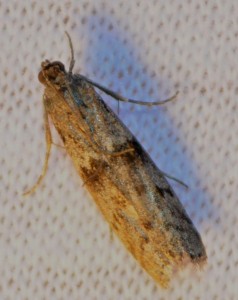
Cacao Moth
The cacao moth(Ephestia elutella) is also known as the tobacco moth and resembles the Mediterranean flour moth and almond moth.
The larvae of the cacao moth mainly feed on dry plant products such as cocoa beans, nuts, dried fruits, and tobacco. They can also attack cereals, dried meat, dry wood, and dead insects.
Almond Moth
The almond moth (Cadra cautella), also known as the fig moth, cacao moth, and chocolate moth, is often confused with the cacao moth and raisin moth.
The almond moth's many nicknames illustrate the wide range of foods it attacks. This includes dried fruits such as dates, figs, raisins, prunes, as well as grains, beans, nuts, chocolate, and more. The larvae can also be cannibalistic and eat their siblings.
Carpet Moth
The carpet moth(Trichophaga tapetiella) differs significantly from other pest moths due to its appearance. Its head and the lower half of its wings are white, while the upper half of its wings is dark.
The carpet moth mainly feeds on animal-based materials such as feathers, fur, hides, and leather. Carpet moths only thrive in humid environments and are much less common today than in the past.
Bee Moth (bumblebee wax moth)
The bee moth(Aphomia sociella) or bumblebee wax moth is one of the larger moth species, growing up to 2 cm in length with a wingspan of up to 4 cm.
The larvae of the bee moth feed on a substance found in insect nests, especially bumblebee nests, but also in wasp nests, hornet nests, bird nests, and beehives.
Yellow V Moth
The yellow v moth(Oinophila v-flava) differs significantly from other moths considered pests, as they do not attack food or textiles.
In nature, the larvae of the yellow v moth mainly feed on bark on small trees and shrubs. In households and businesses, they are primarily found in damp basements, where they feed on mould on walls and can also attack mouldy corks (in wine bottles) and some dried foods.
Raisin Moth
The raisin moth(Cadra figulilella) is often confused with the almond moth.
The larvae of the raisin moth mainly feed on dried fruits such as raisins, figs, and dates, but also on damaged or mouldy grapes on vines. Raisins are attacked until they become too dry. In addition, raisin moths can also feed on cocoa beans, cashew nuts, and fallen berries.
Other Terms
House Moth
House moth is a loose term used for moths that thrive in homes. In practice, it is primarily used for clothes moths but also refers to case-bearing clothes moths, brown house moths, and Indian meal moths, as these are the most commonly found moths in US homes.
Moths Who Attack Clothes and Textiles
This is a collective term for moths that lay their eggs on textiles. The larvae typically feed on the fabric they hatch on, damaging it in the process.
When referring to moths that attack clothes, the term especially refers to clothes moths and case-bearing clothes moths, as these are the main species that attack clothing. However, brown house moths can also attack textiles, so they are included in this category.
Read more about moths who attack clothes and textiles here.
Food Moths
Food moths are a group of moths that lay their eggs on food. The larvae feed on the food they hatch on, damaging it in the process.
Although food moths include all moths that lay eggs on food, the term is especially used for brown house moths and Indian meal moths, as they are the most common food moths in the US.

